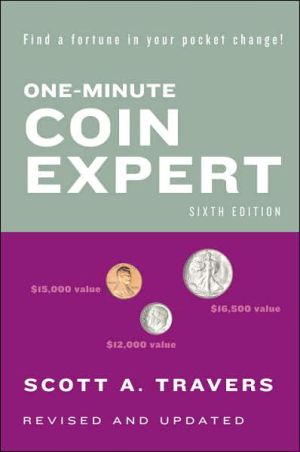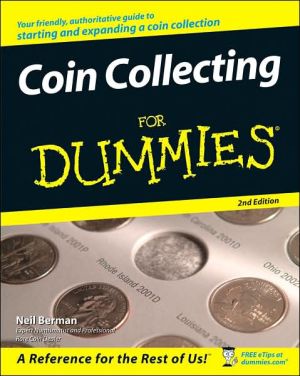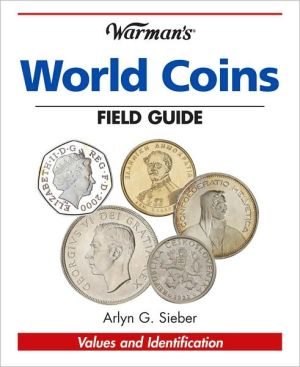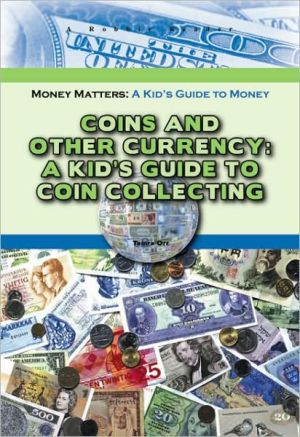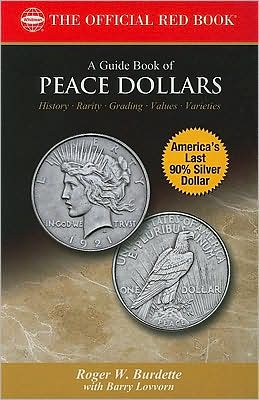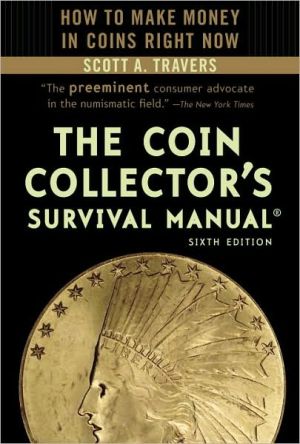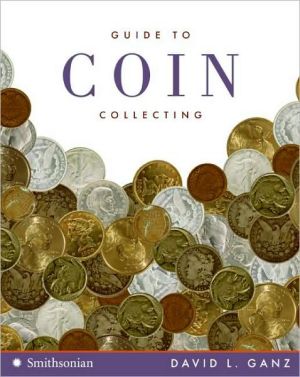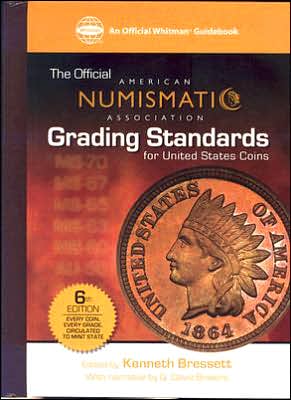One-Minute Coin Expert
Collecting rare coins has become a lucrative global game. Now the award-winning, top-selling One-Minute Coin Expert has been completely revised and updated to show you how to play. Scott Travers teaches readers everything from how to recognize valuable coins in pocket change to how to make a mint trading gold coins. A must for beginners and a valuable resource for experienced collectors, this book includes:\ ·New photos of valuable coins, such as State Quarters and Presidential dollars, that...
Search in google:
Collecting rare coins has become a lucrative global game. Now the award-winning, top-selling One-Minute Coin Expert has been completely revised and updated to show you how to play. Scott Travers teaches readers everything from how to recognize valuable coins in pocket change to how to make a mint trading gold coins. A must for beginners and a valuable resource for experienced collectors, this book includes:·New photos of valuable coins, such as State Quarters and Presidential dollars, that will help to convert that jar of change into a treasure chest·Tips for identifying tiny differences that make small coins worth big money ·Secrets of how to grade, trade, and preserve coins like the experts
CHAPTER 1\ \ YOU CAN BE AN EXPERT\ \ This is a book on how to become an expert on coins.\ \ Expertise on coins can take many forms. It can mean becoming adroit at checking pocket change for coins that will bring you a financial windfall. It also can mean becoming astute at spending money on coins, whether you’re reaching into your pocket for one hundred dollars to buy a rare coin, or even reaching deep into your bank account for many thousands of dollars to spend on extremely rare coins in hopes of achieving a profit.\ \ Whatever your degree of involvement, this book will make you an expert. And if you become an expert, you can profit from rare coins at every level of involvement, regardless of whether current market conditions are good or bad.\ \ At one time or another, possibly without even realizing it, just about everyone thinks about coins as an investment. It happens, for example, when a really old coin turns up in your change or in your travels, or when you get a coin that just doesn’t look right—one, for example, on which the date and some of the words are misprinted.\ \ Many of us have had this experience. And when it happens, we invariably want to know two things: What’s it worth, and will I make more money if I sell it now or later?\ \ You don’t have to wait for scarce and valuable coins to come along; you can go looking for them. And you can make money by buying and selling scarce coins. Many such coins today are authenticated and graded by independent experts and then encased in special plastic holders. This process assures the buyer that the grade, or level of preservation, is being properly stated by the seller.“Certified” coins change hands readily on nationwide trading networks and greatly enhance the appeal of rare coins to traditional investors.\ \ I’ve come up with simple, easy-to-follow guidelines that will take you step by step through the process of identifying good values at all levels of the coin-buying spectrum. Follow these steps and you’ll not only know what to look for, but also what to do with the coins once you have them.\ \ Coins go up and down in value frequently; the coin market has peaks and valleys. But I’ll show you how to make money in all kinds of markets—when coins are red-hot and also when prices are in a tailspin. That, after all, is the sign of a real expert: knowing how to thrive whether the coin market is rallying or is in one of its characteristic cyclical downturns.\ \ WHY PEOPLE ACQUIRE COINS\ \ People save coins for a number of different reasons. Some find them appealing as miniature works of art. Others are intrigued by the rich historical significance they possess. Many simply enjoy the challenge of pursuing something rare, elusive, and valuable. And, not least of all, many are attracted by the marvelous track record rare coins have achieved as good investments. Obviously, a great many people collect rare coins for all these different reasons, to a greater or lesser degree.\ \ Finding something valuable is understandably thrilling, and many scarce coins do turn up in ordinary pocket change. I’ll furnish a list of such coins in Chapter Two. Realistically, though, many rare coins have to be purchased.\ \ Billions of dollars are spent on rare coins every year, and U.S. coins are by far the biggest segment of that market. In large part, that’s because Americans account for the single biggest group of collectors in the world, as well as being among the most affluent. But other factors also have a bearing. For one thing, U.S. coins require less in-depth knowledge than ancient coins or international coins from the modern era. For another thing, the U.S. coin market is an easy-entry, easy-exit field with no regulation by the government—and many entrepreneurs find this appealing.\ \ THE COIN BUYER SPECTRUM\ \ The rare coin market is really a spectrum of different kinds of buyers. While one group of buyers may have different motivations from other groups, all are integral parts of the overall market—and all, in a real sense, are interdependent.\ \ We can better understand who buys and saves coins, and why, by looking at the following graphic:\ \ Accumulators—Accumulators are people who save coins haphazardly, without a particular pattern or plan of action. Many are undoubtedly attracted by the same positive qualities that motivate collectors and investors: the physical appeal of the coins and the notion of selling them for a profit, for example. But these objectives are only vaguely defined.\ \ An accumulator may have sugar bowls or jars filled with coins, but they’re probably not arranged in any special order and he probably doesn’t have a very good idea what they’re worth—even though some of them may be worth a great deal.\ \ Collectors—In theory, a collector is someone who purchases coins with no regard at all for their profit potential—someone who is motivated strictly by such factors as aesthetics and historical significance. If a collector purchased a coin for $100 and its value went up to $1,000, he wouldn’t even consider selling that coin, since he wouldn’t have any interest in the coin’s financial aspects. Theoretically, a collector also wouldn’t concern himself with how much he had to pay to obtain a coin.\ \ Collectors enjoy assembling coins in sets, and they strive for completeness in those sets. Lincoln cents with wheat stalks on the reverse were issued, for example, from 1909 to 1958. A collector would be interested in putting together representative Lincoln cents from each of those years so that she would have a complete set. Some collectors also like to assemble “type” collections, consisting of one coin from each of a number of different series. A twentieth-century type set of U.S. coins, for instance, would include one example of every different U.S. coin issued since 1901. A “type” coin is a representative example of a major coin variety but not a rare date of that variety.\ \ Investors—On the other end of the spectrum, at the right-hand side of our graphic, is the investor. Unlike the collector, the investor pays close attention to inflation, interest rates, the size of the money supply—and, in short, the economic justification for purchasing rare coins. The quintessential investor, in fact, would be concerned only with profit, and not at all with coins’ aesthetics and history.\ \ CollectorInvestors—In practical terms, no one is ever a totally solid collector or solid investor. Even the most dedicated collectors can’t be completely oblivious to the cost and the value of their coins. And even the most profit-oriented investor can’t completely ignore the intangible allure of beautiful coins.\ \ The collectorinvestor combines the best of both worlds. This is a person who buys coins not only for their cultural, historical, and artistic appeal, but also to make a profit. The collectorinvestor represents a new breed of coin buyer, and a very healthy one.\ \ OLD-TIME COLLECTING\ \ Years ago, many people set aside interesting coins: circulated coins they found in pocket change, rolls of brand new coins they obtained at face value from the bank, or possibly government proof sets they purchased for modest premiums from the Mint. These coins may not have been particularly valuable at the time, but over the years coin collecting has evolved from a small hobby into a big business. And today, these tiny treasures may very well command enormous premiums.\ \ As with anything else, it’s a matter of supply and demand. Many of these coins, rolls, and proof sets have been in small supply since the day they were made. But years ago, the number of collectors was also relatively small, so demand for these coins remained at moderate levels. That served to hold down their prices.\ \ Coin collecting became much more popular in the early 1960s. Thousands and thousands of newcomers started looking for low-mintage coins in their pocket change; many would go to the bank and get rolls of coins every week, then take them home and pick out the scarcer pieces. During that period, many people also began to purchase proof sets from the government every year. The expansion continued and accelerated during the 1970s and into the 1980s.\ \ THE COMING OF THE INVESTOR\ \ Investors began to enter the coin market in large numbers in the mid to late 1970s. The timing was no accident: Coins, like precious metals, have come to be viewed as hedges against economic calamities, and the late 1970s were years of unusual turbulence economically. Inflation was on the rise and many people were skeptical of the government’s ability to control it. They also were wary of conventional investments such as stocks. Driven by these fears, many turned to tangible assets and diverted large sums of money into gold, silver, and other such investments—including coins. Some combined their interest in coins and precious metals by buying bullion coins. These are coins whose value goes up or down in accordance with the value of the metal they contain—usually gold or silver. We’ll discuss these in greater detail in a later chapter.\ \ During the period ending in early 1980, the coin market experienced the most tremendous boom it has ever enjoyed.\ \ THE GROWTH OF COLLECTINGINVESTING\ \ As the number of collectors and investors expanded, so did the demand for better-date coins. The results were entirely predictable: As market demand increased for a fixed (and small) supply, prices began to escalate dramatically. At the same time, more and more people began to approach rare coins as both a collecting outlet and an investment.\ \ Many collectorinvestors are baby boomers grown up: people who possibly started collecting coins when they were twelve or thirteen years old and built a solid foundation, then took a hiatus to pursue other interests such as college, courtship, and careers. Many of these collectorinvestors returned to the field in the mid to late 1980sand returned with a vengeance, bringing with them not only their strong foundation in coins but also finely honed minds and high incomes—testaments to their high degree of success at institutions of higher learning and in their careers.\ \ These people are buying coins like there’s no tomorrow. They have substantial sums of money at their disposal and they’re savoring the chance to spend it on desirable coins. They appreciate every aspect of coins, including the one which can benefit your pocketbook: the financial aspect.\ \ Collectorinvestors have added to the market’s volatile nature—its susceptibility to going up or down in value very quickly.\ \ Collectors and investors—and collectorinvestors—come in different degrees. Many, for example, would fall between the Collector and CollectorInvestor locations on our graphic. The coin buyer spectrum is broad, diverse, and continuous, and buyers can be found across that spectrum.\ \ THREE KINDS OF RARE COINS\ \ For the purposes of this book, there are basically three different kinds of valuable coins.\ \ One group consists of coins that are possible to come across in pocket change. These coins are described in Chapter Two.\ \ Another group consists of coins you’d have to purchase. These tend to be coins with very low mintages and in very high grades or levels of preservation. They’re the kind of coins investors favor. We’ll look at these in greater detail in later chapters.\ \ The third group of coins consists of what might be called “cigar-box rarities.” They’re coins that you might find in a cigar box up in the attic, or stashed away in a shoe box on a shelf at the back of a closet.\ \ “Cigar-box rarities” probably wouldn’t be found in pocket change. Many are coins that aren’t being minted anymore. But most people have such coins sitting around the house, or know of a friend or relative who does. Often, they’ve been handed down by relatives who found them—or maybe even purchased them—years ago. If so, they may be quite valuable. Many coins that were looked upon as common fifty years ago, or even twenty-five years ago, are worth large sums of money in the current marketplace.\ \ The cigar-box rarities which are most valuable—and which you might have a chance of finding—are listed in Chapter Three, along with their fair market value.\ \ There’s an excellent chance that some of these scarce coins—coins that have become quite valuable over the years—may be sitting in your attic, or perhaps in a jewelry case in the back of a dresser drawer. Perhaps your father put them there many years ago, when they were still regarded as not of great consequence, then forgot them. Or maybe they’ve been handed down through generations that go back even farther.\ \ PROOF SETS AND MINT SETS\ \ A proof set is a group of specimen-quality coins, usually bearing a uniform date and housed in protective packaging. Proof coins are made by taking special, highly polished coin blanks and striking them several times with highly polished dies. These are considered the highest-quality coins available. The United States Mint offers proof sets for sale to the public every year.\ \ A mint set, by contrast, consists of business-strike coins: the kind that are produced for circulation. A mint set contains one example of each different coin struck for circulation in any given year by each of the different mints. The coins in such a set may have been chosen carefully, but they’re business strikes just the same.\ \ Normally, a proof set costs more than a mint set when purchased from the government and also has higher value in the resale market. However, on occasion a mint set may be more valuable in the resale market than the corresponding proof set for that year. This may happen, for example, if the mint set contains a coin that wasn’t actually made for general use. Since the mint set then contains the only circulation-quality example, that coin and that set will command an added premium.\ \ MINT MARKS AND HOW TO LOCATE THEM\ \ Many coins’ values are enhanced by the presence of mint marks. These are little letters denoting the mint facility where the coins were manufactured.\ \ During its earliest years, the United States Mint had only one production plant-in Philadelphia-and so there was no need to identify the source of any coins. As the nation grew and coinage requirements rose, branch mints were established in cities around the country. Each of these branches placed a mint mark on its coins to distinguish them readily from those being made at other mints.\ \ Following are the letters used on U.S. coins to denote branch mints:\ \ \ C—Charlotte, North Carolina (1838—1861, gold coins only)\ \ CC—Carson City, Nevada (1870—1893)\ \ D—Dahlonega, Georgia (1838—1861, gold coins only)\ \ D—Denver (1906 to date)\ \ O—New Orleans (1838—1909)\ \ S—San Francisco (1854 to date)\ \ W—West Point, New York (1984 to date)\ \ Throughout most of U.S. history, coins produced at the main mint in Philadelphia carried no mint mark. Their origin was denoted by the absence of any such mark. In recent years, however, a small P has been placed on most coins produced in Philadelphia. This practice began in 1979, when the P mint mark was used on the Susan B. Anthony dollar. The following year, it was added to all other coins with one exception: No P has been used on Lincoln cents.\ \ A Philadelphia mint mark was used one other time. During World War II, nickel was urgently needed for war-related purposes, so from 1942 through 1945 the Mint used a substitute alloy without any nickel in making five-cent pieces. The emergency alloy’s components were copper, silver, and manganese. To denote this change in composition, the Mint placed large mint marks above Monticello’s dome on the coins’ reverse—including a large, slender P on non-nickel “nickels” produced during those years in Philadelphia. (The reverse of a coin is what is commonly known as the “tails” side and carries the monetary value of the coin. The obverse or “heads” side commonly carries a portrait and the year of the coin’s issue.)\ \ On nineteenth-century coins, the mint mark was usually placed at the base of the reverse, below the wreath or eagle depicted on that side. Mint marks’ locations have varied a great deal more on twentieth-century coins, and some coins have carried them in several different places at different times.\ \ Here’s a checklist of where to look for mint marks on some of the coins you’re most likely to encounter in current pocket change or older hoards:\ \ \ * Lincoln cent (1909 to date)—below the date.\ \ * Indian Head cent (1859—1909)—below the wreath (mint marks appear only on coins dated 1908 and 1909).\ \ * Jefferson nickel (1938 to date)—on the reverse, to the right of Monticello, on most dates from 1938 to 1964; above Monticello on war nickels from 1942 to 1945; below the date from 1968 to the present.\ \ * Buffalo nickel (1913—1938)—on the reverse, below the words FIVE CENTS.\ \ * Liberty Head nickel (1883—1912)—on the reverse, to the left of the word CENTS (mint marks appear only on coins dated 1912).\ \ * Roosevelt dime (1946 to date)—on the reverse, to the left of the torch’s base, from 1946 to 1964; above the date from 1968 to the present.\ \ * “Mercury” dime (1916—1945)—on the reverse, to the left of the fasces (the symbolic bundle of rods).\ \ * Barber dime (1892—1916)—below the wreath.\ \ * Washington quarter (1932 to date)—below the wreath from 1932 to 1964; to the right of George Washington’s pigtail from 1968 to the present.\ \ * Standing Liberty quarter (1916—1930)—to the left of the date. (NOTE: The M to the right of the date is not a mint mark; it stands for Hermon MacNeil, the coin’s designer.)\ \ * Barber quarter (1892—1916)—below the eagle.\ \ * Kennedy half dollar (1964 to date)—to the left of the eagle’s tail feathers in 1964; below John F. Kennedy’s neck from 1968 to the present.\ \ * Walking Liberty half dol below IN GOD WE TRUST, in 1916 and 1917; on the reverse, above and to the left of HALF DOLLAR, from 1917 to 1947 (1917 examples come in both varieties).\ \ * Barber half dollar (1892—1915)—below the eagle.\ \ * Anthony dollar (1979—1981)—above Susan B. Anthony’s right shoulder.\ \ * Eisenhower dollar (1971—1978)—below Dwight D. Eisenhower’s neck.\ \ * Peace silver dollar (1921—1935)—on the reverse, below the word ONE.\ \ * Morgan silver dollar (1878—1921)—below the wreath.\ \ * Saint-Gaudens $20 gold piece (1907—1933)—above the date.\ \ * Liberty Head $20 gold piece (1850—1907)—below the eagle.\ \ Now that you have some idea of where you fall on the collectorinvestor spectrum and the different types of coins that are available to you, it’s time to take a closer look at the coins you already have—in your pocket change.\ \ \ \
Preface and AcknowledgmentsIntroduction1Ch. 1You Can Be an Expert8Ch. 2A Fortune in Pocket Change21Ch. 3Making Money With Coins60Ch. 4Answers to the Most-Asked Coin Questions109Ch. 5Marketplace Psychology123Ch. 6Grading in Five Easy Steps146Ch. 7Trading Coins Like Stocks168Ch. 8How You Can Make Big Profits from Small Coins193Ch. 9How to Cash in Those Big Profits215Ch. 10Scott Travers' Secret Top Ten228Ch. 11Coins and Precious Metals248Ch. 12Coin Dealers, Drug Dealers, and the Government265Epilogue271
